Term 3 Chapter 1 | 4th Science - Green Environment | 4th Science : Term 3 Unit 1 : Green Environment
Chapter: 4th Science : Term 3 Unit 1 : Green Environment
Green Environment
Unit 1
GREEN ENVIRONMENT

Learning Objectives
After the completion of this unit
students will be able to
• understand the importance of
waste management
• understand
the role of 3Rs in waste management
• learn
how to conserve the environment by practising good habits
• recognise
eco-friendly materials
Introduction
Nature provides us a lot of
useful things. But human beings exploit the natural resources and create more
trash. These unwanted materials thrown away are called wastes. They can be
solid, liquid and gas. They are produced from households, industries, hospitals
etc., These unwanted materials pollute our environment.
Waste Management
Sristhika : Madam, I see a lot of waste things in our
surrounding. Is there any way we can reduce wasting
things?
Teacher: Yes. There are many ways to
reduce waste. Reducing the waste is the first and most important step in waste
management.
Vimal : What is waste management, Madam?
Teacher: It is the step we take to
handle our waste and to make sure our environment does not get dirty and
polluted. Waste management deals with both biodegradable and non-biodegradable
waste.
Janani: Can you please explain the
steps in waste management Madam?
Teacher: Yes, sure. There are four steps
in waste management. They are
1. Separation of Waste
2. Waste collection and
transportation
3. Waste recycling and composting
4. Waste disposal
1. Separation of
Waste: This is a very important step in waste management.
It means to sort or divide the waste into different waste bins. Each bin should
have different type of wastes. It is good to separate waste in three different
bins. Green for biodegradable waste, Blue for recyclable waste and Red for
non-recyclable waste. Non-biodegradable waste can be classified as recyclable
and non-recyclable.

Biodegradable, Recyclable, Non-recyclable
2. Waste collection
and transportation: Once we separate our waste in our homes and
schools, it is important to keep it ready to be picked up by our municipality
or corporation. Picking up the waste is called Waste collection. Moving the
waste from one place to another is called Transportation.
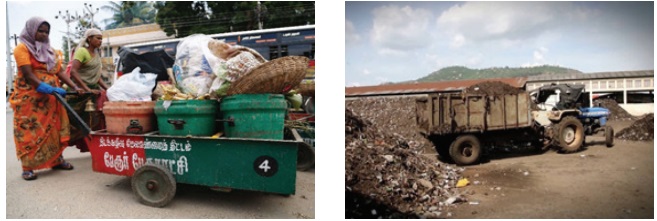
3. Waste recycling
and composting: Biodegradable waste is taken to a place where
it can be converted into compost. Compost makes the soil fertile.
Non-biodegradable waste that can be turned into something new (recyclable
waste) and valuable is taken to recycling factory.

4. Waste disposal: The waste that cannot be recycled
(non-recyclable waste) needs to be sent for final disposal. This waste is sent
to an open dump or landfill.
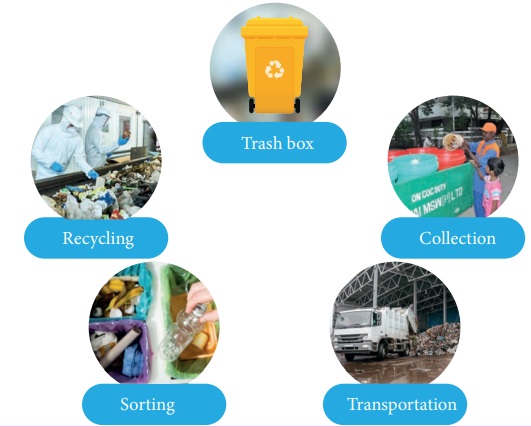
Trash box, Recycling, Collection, Sorting, Transportation
ACTIVITY
Write the waste
management process in the correct order.
(Waste disposal,
Waste collection and transportation, Waste separation, Waste recycling and composting)
1. Waste separation
2. Waste collection
and transportation
3. Waste recycling and
composting
4. Waste disposal
Rahul : How can we manage waste at home?
Teacher: There are many things we and
our family can do to manage waste at home. Three R‛s help to manage waste.
Gomathi: What are the three R‛s, Madam?
Teacher: The three R‛s stand for REDUCE, REUSE, RECYCLE. We must first
reduce, then reuse and finally recycle.
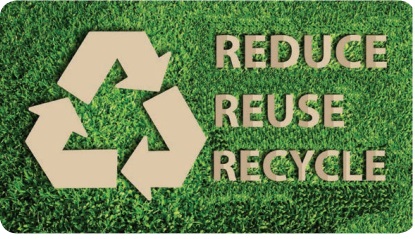
THE 3 R‛s
Reduce is to make or use less materials. This is to
make, buy and use things that create less waste. It is the best thing to do
first and it is easy to ask yourself – How can I make less waste? Some examples
are given below.

1. You can buy a refill pen and
change the refill only when the ink is used up.
2. While shopping with your parents, you can carry a cloth bag.
In this way you can avoid buying plastic carry bags.
3. Turn off lights and fans when
you leave a room.
4. Close the tap while you are
brushing your teeth.
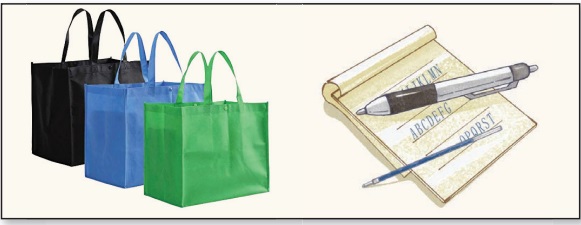
ACTIVITY
List out four things that you can reduce, reuse and recycle at home or school.

Reuse is using a thing repeatedly for the same or
for another purpose. By reusing, we throw away less waste and do not dispose it
in a dump. Reuse saves money, energy and time. Here are some examples of how
you can reuse materials at home.

1. You can reuse old clothes as a
rag to clean your home or even wash your cycle.
2. You can reuse jam and pickle
jars to store things.
3. You can donate old clothes
that still look good to poor and needy children.
4. You can reuse waste and make
something new. E.g. You can reuse a plastic bottle as a pen stand or a bird
feeder.

Recycle is to take materials from things you throw
away and make new products by using them. Recycling takes energy and time but
saves the amount of ‘new‛ resources we need to make things. E.g. water,
minerals, wood.


Here are some examples of how
certain materials are recycled.
1. Old newspapers, note books and magazines are separated and sold to a scrap dealer. They will be made into new papers.
2. PET bottles are recycled into
plastic threads and then used to make sports T-shirts.
3. Old glass bottles and broken
glass pieces are melted to make new glass.
4. Broken metal items like tiffin boxes and plates are melted and made into new metal products like toys.
ACTIVITY
Using old water
bottles, make different things such as Bird feeder, Flower vase, Pen holder and
Wall hanging as shown below.
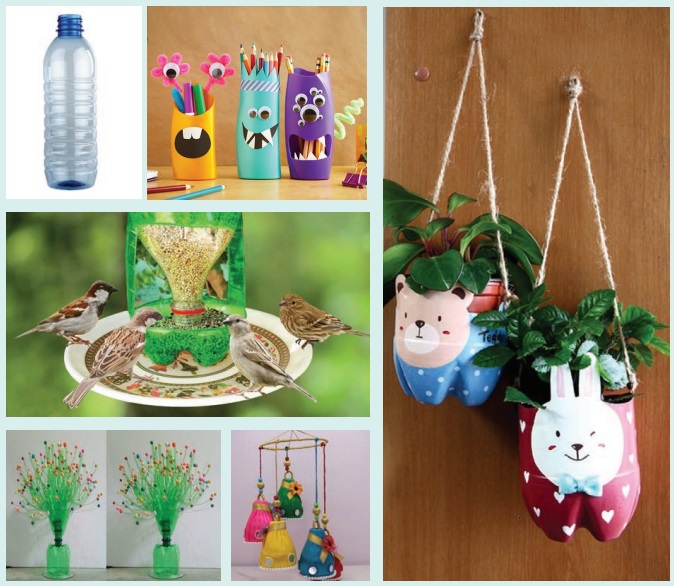
Conserve our
Environment
Rahul : What is meant by conservation of environment, Madam?
Teacher: Conservation of environment
means to protect all things found in nature. It means that we have to use our
Earth‛s natural resources (like water, soil, minerals, wildlife and forests) carefully.
Vimal : How can I conserve the environment?
Teacher : Everyone can conserve the environment by
following good waste management habits.
What is the first ‘R‛ in the
three R‛s?
Kanimozhi : Reduce.
Teacher : Correct! We should first try to reduce the waste we make. Thus, we can
easily conserve the environment. We can also separate our waste at home to keep
our place litter free and clean.
Waste Separation
Waste at home should be separated
into biodegradable, recyclable and non-recyclable waste. Waste like left over
food, vegetable waste which are broken down naturally should be collected in a
separate litter box. Materials which cannot be decomposed should be placed in
separate dustbin. Paper waste, glass waste and aluminium waste which can be
recycled into new useful products should be kept in separate box.

Do you Know?
Glass containers for food and beverages are 100%
recyclable and can be recycled endlessly without loss in quality or purity.
ACTIVITY
Study the images
below and write down three items you have at home in each category of waste.
Biodegradable | Recyclable items | Non-recyclable items
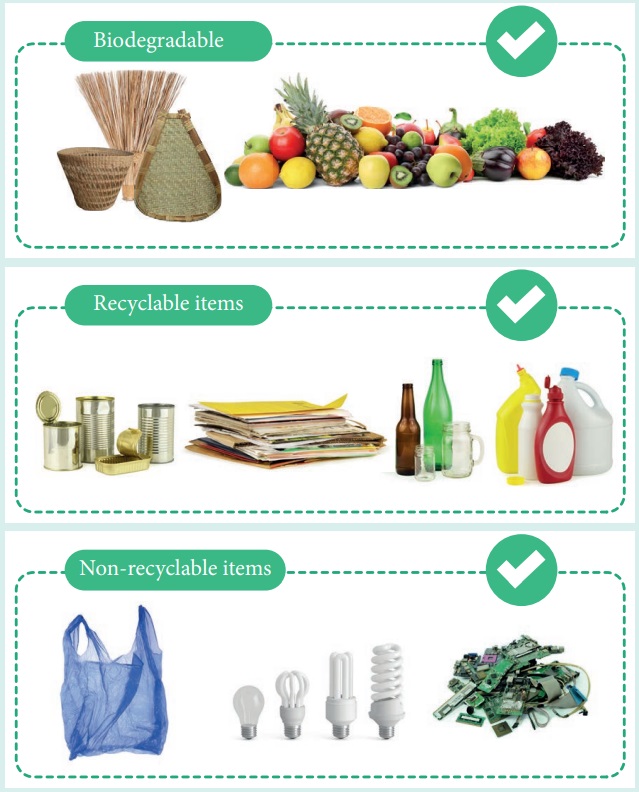
1. Biodegradable: Fruits, Vegetables,
Seeds, Nuts
2. Recyclable: Paper, plastics,
glass, metal
3. Non-recyclable: Medical waste, CFL
lights, Plastic bags, Polystyrene
Sristhika : I have heard the news that plastic is
harmful to our environment. Is it true Mam?
Teacher : Plastic itself is not bad but we are using too much of it. Over use of
plastic causes pollution. Plastics that are used only one time causes
pollution. It is good to avoid or reduce one-time usable plastics. The best way
to start is to ask yourself this question. Is this plastic item going to be
used one time or many times? If you can use it only once, then try to avoid
buying such plastic items.
Plastics in Tamil Nadu
Tamil Nadu is leading the way in
India by banning some one-time use plastic items. List of items banned in Tamil
Nadu are given below.
Animals eat plastic bags by accident and their food passage is choked.
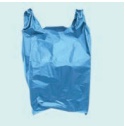
Plastic plates stay in the environment for over 1000 years.
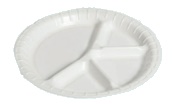
Water pouches litter the land and are difficult to recycle.

Plastic straws are difficult to recycle and end up polluting
the ocean.
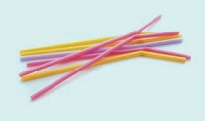
Chemicals from plastic sheets leak into
food.

Ekalaivan : What are the things that can be used instead of plastic, Madam?
Teacher : We can use things
that are harmless for the environment. These are called environment friendly
or eco-friendly materials, and can be either biodegradable or reusable.
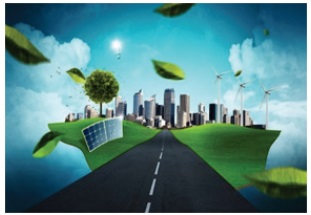
Environment
friendly materials
Things that can be decomposed or
broken down by microorganisms are biodegradable. They can return to the soil
and enrich the soil. Materials which are beneficial to the environment and do
not cause harm are called eco-friendly materials.
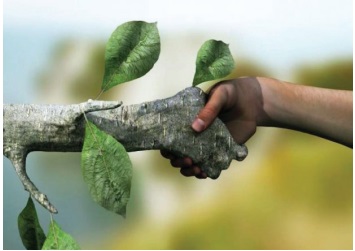
For example, banana leaves are
used as plates. They are fully biodegradable and do not contain chemicals like
thermocol plastic or coated paper plates.
Bamboo is used to make many
things such as bags, dustbins and even toothbrushes.

Eco-friendly
Activities:
• Reduce your paper use by writing on both sides of every sheet.
• Stop using plastic straws.
• Use reusable bag.
• Give up chewing gum.
• Buy stainless steel bottles instead of plastic water bottles.
• Reuse containers for storing left overs.
Do you Know?
The first fully synthetic plastic was invented by
Leo Baekeland in 1907
ACTIVITY
Form small groups
and start collecting plastic litter from school grounds or from the local area
around your house.
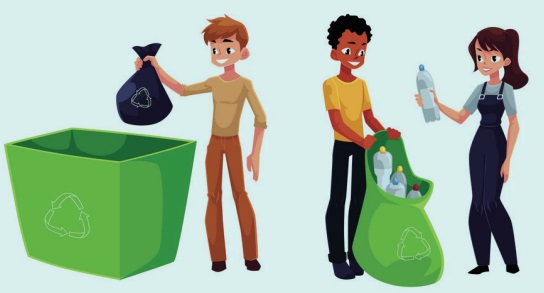
Teacher : Some environment friendly materials are not
biodegradable but very strong and can be used for many years. Reuse is the
second R in three R‛s. By reusing something again and again, we reduce waste
and conserve the environment.
Rahul : Can you please give
us some examples?
Teacher : Yes, sure.
Stainless steel water bottle and
snack box are some examples of eco-friendly materials.
Stainless steel does not leak chemicals into your food or water. So it is safer
than plastic. These can be reused for a longer period of time.

ACTIVITY
Write any five
non-recyclable items that you use or have seen in shop.
Answer: 1 .Plastic carry bags 2. Straw 3. Plastic plates 4. Plastic
sheets 5. Water pouches
Litter Free
Environment
Litter in our environment is
unsightly and spoils our experience of nature. It is also dangerous to animals
that ingest it. Cleaning up loose waste is one of the best ways to keep our
community and the environment green. By removing litter from environment, we
are ensuring that it does not end up in our oceans.
National Green
Corps (NGC)
It is a national programme
initiated by the Government of India. The motto of NGC is “Where there is
Green, there is Prosperity”
It involves NGC school students
in protecting and promoting the conservation of natural resources. They
participate in activities like biodiversity conservation and waste management.
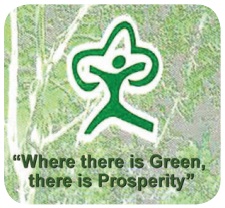
Make sure you put
litter in a bag or in a dustbin.
When others pass you as you pick up litter, smile and say hello. It shows pride in community and encourages others to do their part
Related Topics